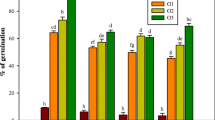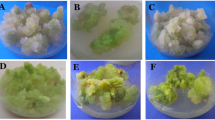Abstract
Dendrocalamus asper, an edible bamboo is valued for its tender edible shoots in the food industry. However, overexploitation of natural stands of D. asper coupled with minimal conservation and reforestation efforts has led to its rapid depletion in nature. Therefore protocol for rapid multiplication of D. asper via direct regeneration using nodal segments from mature clumps was standardized and more than 25,000 plants were transferred to the field (Singh et al. 2012a). However, genetic fidelity of these in vitro raised plants needs to be authenticated for commercial scale application of the developed micropropagation protocol. PCR-based molecular markers have emerged as simple, fast, reliable and labor-effective tools for testing the genetic fidelity of in vitro raised plants. This study report the genetic fidelity analysis of in vitro raised plants of D. asper for the first time using arbitrary (Random Amplified Polymorphic DNA, RAPD), semi-arbitrary (Inter-Simple Sequence Repeat, ISSR; Amplified Fragment Length Polymorphism, AFLP), and sequence-based (Simple Sequence Repeat, SSR) markers. Bulked DNA samples of 20 in vitro raised shoots (collected after every three subculture cycles starting from 3rd to 30th passage) and field transferred plantlets were compared with the mother plant DNA using 90 primer combinations (25 each of RAPD, ISSR, SSR, and 15 AFLP) and scorable bands were produced by 78 (22 RAPD, 24 ISSR, 21 SSR, and 11 AFLP) primers. A total of 146 distinct and scorable bands were produced by 22 RAPD primers with an average of 6.6 bands per primer while the number of bands for ISSR primers varied from 3 (ISSR-4 and 9) to 13 (ISSR-17), with an average of 7.1 bands per primer. Similarly, SSR markers also showed wide variation in number of bands, ranging from 2 (RM 261) to 12 (RM 44, 140, and 224) with an average of 7.8 bands. AFLP primer combinations could generate 35–72 bands with an average of 48.7 bands per primer pair. Amplification of monomorphic bands with all primer combinations authenticated the true to type nature of the in vitro raised plants of D. asper which underwent up to 30 subculture passages over a period of approximately 2 years thereby supporting the commercial utilization of the developed micropropagation protocol.



Similar content being viewed by others
Abbreviations
- AdS:
-
Adenine sulfate
- AFLP:
-
Amplified fragment length polymorphism
- BAP:
-
6-Benzyl-amino-purine
- CTAB:
-
Cetyl trimethyl ammonium bromide
- dNTPs:
-
Deoxyribonucleotide triphosphates
- FYM:
-
Farm yard manure
- IBA:
-
Indole-3-butyric acid
- ISSR:
-
Inter-simple sequence repeat
- MS:
-
Murashige and Skoog’s medium
- NAA:
-
α-Naphthalene acetic acid
- PCR:
-
Polymerase chain reaction
- RAPD:
-
Random amplified polymorphic DNA
- RFLP:
-
Restriction fragment length polymorphism
- SSR:
-
Simple sequence repeat
References
Agnihotri RK, Mishra J, Nandi SK (2009) Improved in vitro shoot multiplication and rooting of Dendrocalamus hamiltonii Nees et Arn. ex Munro: production of genetically uniform plants and field evaluation. Acta Physiol Plant 31:961–967
Arya ID, Arya S (1997) In vitro culture and establishment of exotic bamboo Dendrocalamus asper. Indian J Exp Biol 35:1252–1255
Arya S, Sharma S, Kaur R, Arya ID (1999) Micropropagation of Dendrocalamus asper by shoot proliferation using seeds. Plant Cell Rep 18:879–882
Arya S, Satsangi R, Arya ID (2002) Rapid mass multiplication of edible bamboo Dendrocalamus asper. J Sustain Forest 4:103–109
Arya S, Satsangi R, Arya ID (2008) Large scale production of edible bamboo Dendrocalamus asper through somatic embryogenesis. J Am Bamboo Soc 21:13–23
Banerjee M, Saikat G, Pramanik BR (2011) A two step method for accelerated mass propagation of Dendrocalamus asper and their field evaluation. Physiol Mol Biol Plant 17:387–393
Bisht P, Pant M, Kant A (2010) In vitro propagation of Gigantochloa atroviolaceae Widjaja through nodal explants. J Am Sci 6:1019–1026
Cuesta C, Ordas RJ, Rodriguez A, Fernandez B (2010) PCR-based molecular markers for assessment of somaclonal variation in Pinus pinea clones micropropagated in vitro. Biol Pl 54:435–442
Das M, Pal A (2005) In vitro regeneration of Bambusa balcooa Roxb, factors affecting changes of morphogenetic competence in the axillary buds. Plant Cell Tiss Org Cult 81:109–112
Dunstan DI, Thorpe TA (1986) Regeneration in forest trees. In: Vasil IK (ed) Cell culture and somatic cell genetics of plants, vol 3. Academic Press, Orlando, pp 223–241
Heinz B, Schmidt J (1995) Monitoring genetic fidelity vs somaclonal variation in Norway Spruce (Picea abies) somatic embryogenesis by RAPD analysis. Euphytica 85:341–345
Joshi P, Dhawan V (2007) Assessment of genetic fidelity of micropropagated Swertia chirayita plantlets by ISSR marker assay. Biol Plant 51:22–26
Kalia RK, Rai MK, Kalia S, Singh R, Dhawan AK (2011) Microsatellite markers: an overview of the recent progress in plants. Euphytica 177:309–334
Lakshmanan V, Venkataramareddy SR, Neelwarne B (2007) Molecular analysis of genetic stability in long-term micropropagated shoots of banana using RAPD and ISSR markers. Electron J Biotechnol 10:106–113
Leroy XJ, Leon K, Charles G, Branchard M (2000) Cauliflower somatic embryogenesis and analysis of regenerant stability by ISSRs. Plant Cell Rep 19:1102–1107
Lodhi MA, Ye GN, Weeden NF, Reisch BI (1994) A simple and efficient method of DNA extraction from grapevine cultivars and Vitis species. Plant Mol Biol Rep 12:6–13
Martins M, Sarmento D, Oliveira MM (2004) Genetic stability of micropropagated almond plantlets as assessed by RAPD and ISSR markers. Plant Cell Rep 23:492–496
Marulanda ML, Lopez AM, Claroz JL (2007) Analyzing the genetic diversity of Guadua spp. in Colombia using rice and sugarcane microsatellites. Crop Breed Appl Biotechnol 7:43–51
McGregor CE, Lambert CA, Greyling MM, Louw JH, Warnich L (2000) A comparative assessment of DNA fingerprinting techniques (RAPD, ISSR, AFLP and SSR) in tetraploid potato (Solanum tuberosum L.) germplasm. Euphytica 113:135–144
Mehta R, Sharma V, Sood A, Sharma M, Sharma RK (2011) Induction of somatic embryogenesis and analysis of genetic fidelity of in vitro-derived plantlets of Bambusa nutans Wall., using AFLP markers. Eur J Forest Res 130:729–736
Nadha HK, Kumar R, Sharma RK, Anand M, Sood A (2011) Evaluation of clonal fidelity of in vitro raised plants of Guadua angustifolia Kunth using DNA-based markers. J Med Plants Res 5:563–5641
Negi D, Saxena S (2010) Ascertaining clonal fidelity of tissue culture raised plants of Bambusa balcooa Roxb. using inter simple sequence repeat markers. New Forest 40:1–8
Negi D, Saxena S (2011) In vitro propagation of B. nutans Wall. ex Munro through axillary shoot proliferation. Plant Biotechnol Rep 5:35–43
Ojha A, Verma N, Kumar A (2009) In vitro micropropagation of economically important edible bamboo (Dendrocalamus asper) through somatic embryos from root, leaves and nodal segments explants. Res Crops 10:430–436
Palombi MA, Damiano C (2002) Comparison between RAPD and SSR molecular markers in detecting genetic variation in kiwifruit (Actinidia deliciosa A. Chev.). Plant Cell Rep 20:1061–1066
Panda MK, Mohanty S, Subudhi E, Acharya L, Nayak S (2007) Assessment of genetic stability of micropropagated plants of Curcuma longa L. by cytophotometry and RAPD analyses. Int J Integr Biol 1:189–195
Pandey RN, Singh SP, Rastogi J, Sharma ML, Singh RK (2012) Early assessment of genetic fidelity in sugarcane (Saccharum officinarum) plantlets regenerated through direct organogenesis with RAPD and SSR markers. Aust J Crop Sci 6:618–624
Peschke VM, Phillips RL (1992) Genetic implications of somaclonal variation in plants. Adv Genet 30:41–75
Phillips RL, Kaeppler SM, Olhoft P (1994) Genetic stability of plant tissue cultures: breakdown of normal controls. Proc Natl Acad Sci USA 91:5222–5226
Ramanayake SMSD, Yakandawala K, Nilmini Deepika PKD, Ikbal MCM (1995) Studies on micropropagation of Dendrocalamus giganteus and Bambusa vulgaris var. striata. In: Bamboo, people and the environment, vol. 1, propagation and management. INBAR Tech Rep 8:75–85
Rani V, Raina SN (2000) Genetic fidelity of organized meristem-derived micropropagated plants: a critical reappraisal. In Vitro Cell Dev Biol Plant 36:319–330
Rodrigues PHV, Tulmann Neto A, Cassieri Neto P, Mendes BMJ (1998) Influence of the number of subcultures on somaclonal variation in micropropagated Nanico (Musa spp., AAA group). Acta Hort 490:469–473
Rohlf FJ (2000) NTSYS-pc: numerical taxonomy and multivariate analysis system. Version 2.0 Exeter Software, Setauket, New York, USA
Sambrook J, Fritsch EF, Maniatis T (1989) Molecular cloning: a laboratory manual, 2nd edn. Cold Spring Harbor Laboratory Press, Cold Spring Harbor
Saxena S, Dhawan V (1994) Micropropagation research in south Asia—constraints to production of bamboo and rattan. INBAR Tech Rep 5:101–113
Singh SR, Dalal S, Singh R, Dhawan AK, Kalia RK (2012a) Micropropagation of Dendrocalamus asper {Schult. & Schult. F.} Backer ex K. Heyne): an exotic edible bamboo. J Plant Biochem Biotechnol 21:220–228
Singh SR, Dalal S, Singh R, Dhawan AK, Kalia RK (2012b) Seasonal influences on in vitro bud break in Dendrocalamus hamiltonii Arn. ex Munro nodal explants and effect of culture microenvironment on large scale shoot multiplication and plantlet regeneration. Indian J Plant Physiol 17:9–21
Venkatachalam L, Sreedhar RV, Bhagyalakshmi N (2007) Micropropagation in banana using high levels of cytokinins does not involve any genetic changes as revealed by RAPD and ISSR markers. Plant Growth Regul 51:193–205
Vos P, Hogers R, Bleeker M, Reijans M, Vandelee T, Hornes M, Frijters A, Pot J, Peleman J, Kuiper M, Zabeau M (1995) AFLP—a new technique for DNA-fingerprinting. Nucleic Acids Res 23:4407–4414
Yadav S, Patel P, Shirin F, Mishra Y, Ansari SA (2008) In vitro clonal propagation of 10-year-old clumps of Bambusa nutans. J Bamboo Rattan 7:201–210
Acknowledgments
Our sincere thanks to Director (Technical) CPB and Chairman, Department of Bio- and Nanotechnology, GJUST for providing the laboratory facilities. The Forest Department, Yamuna Nagar (Haryana), is acknowledged for maintenance of tissue culture raised plants in the field. The financial support extended to SRS and RS by Department of Biotechnology, Ministry of Science and Technology, Govt. of India, New Delhi, under project no. BT/PR/5261/AGR/16/459/2004 and BT/PR11091/NDB/51/179/2008 is also gratefully acknowledged.
Author information
Authors and Affiliations
Corresponding author
Additional information
Communicated by B. Borkowska.
Rights and permissions
About this article
Cite this article
Singh, S.R., Dalal, S., Singh, R. et al. Evaluation of genetic fidelity of in vitro raised plants of Dendrocalamus asper (Schult. & Schult. F.) Backer ex K. Heyne using DNA-based markers. Acta Physiol Plant 35, 419–430 (2013). https://doi.org/10.1007/s11738-012-1084-x
Received:
Revised:
Accepted:
Published:
Issue Date:
DOI: https://doi.org/10.1007/s11738-012-1084-x




